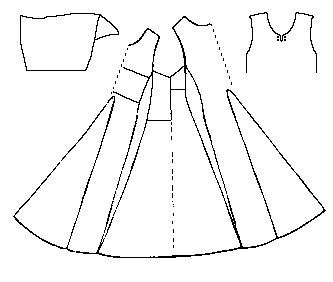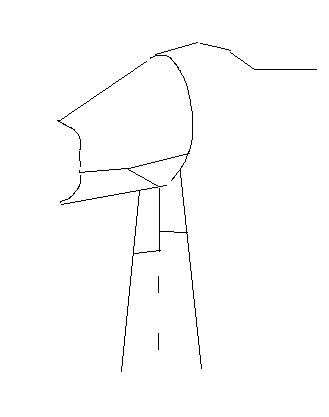
Pattern drawing based on Nörlund

Pattern drawing
based on Nörlund
A short sleeved woman's dress made from a front and back piece with center gores, and two gores on the right side, and a single, wide gore on the left side with a false seam running down the center.
The sleeves are 30 cm (7.9") long, and the bottom is 360 cm (141.7") in circumference. The armhole is 58 cm (22.8") around, while the neck is 70.5 cm around. The waist measurement is 98.5 cm (38.8"). There is a 4.5 cm (1.77") slit in the front, with two pairs of edged eyelet holes. Both the neck and the bottom edge are turned back and sewn with a row of backstitches. The raw edge is overcast. The sleeve ends are simple turned over.
The material is full and heavy and well made. The weaving is "four-shaft" (i.e. 2/2) , with the weft so firmly worked that the warp is no longer visible.
Maggie Forest made a separate examination of the materials of H33, H38, H39, H43, H45, H61, H65 and had the following to say:
The fabric is invariably 2/2 twill. The threads are less than a mm thick, the fabric wasn't fulled. The result is a slightly open weave, which would have held warmth like a modern knitted sweater. The gap between each thread would be about 1/3-1/2 mm - noticeable. The warp is spun with kemp hairs included for strength, the weft is just the soft under coat, and so the fabrics have a distinctive almost tweed-like appearance. The open weave and the twill weave would have made these fabrics drape like dreams. Despite the fact that they weren't terribly tight-fitted (although I have a thought on that too) they would have looked it, because the fabric would have clung quite closely.
The seams are just amazingly fine. They're done from the same thread as the fabric is woven from, and stitches are frequently only about 1mm long. There are places where Nörlund states that there is no hem, only a fold-over, but in fact there is a seam there, it's just so fine you need to look under the microscope. Leaning back, you can just see a shadow line from the seams, but the stitches are minute.
[The Greenlanders] used a stitch now known as priksom for a top stitch. It is a running stitch, but it goes through the fabric diagonally and ends up looking totally like a modern machine seam, with each stitch butting close to the next..
The tablet woven edge that is extant in the London material also appears in the Greenland material. A couple of the hoods have a quite wide edge, about 1.5 cm wide, done in this way, which gives a really distinctive looking edge with wide stitches on the back. Very tidy.
[Forest agrees with Robin Netherton's assertion that the Nörlund's pattern diagrams are flawed.] They really look nothing like it. This may be because he drew the diagrams before the first conservation, but for example, there really aren't those curves in the 39 gown.
The false seams were not used to add additional fit - they are even all the way through the garment.
The sleeve settings: I've been following the pictures and setting the sleeve from just below the shoulder bone and working the gusset down from there. This is indeed how most of the garments are, and tallies well with modern tailoring techniques - as anyone who's done a tailored jacket knows. Problem is, all the sleeves had been ripped off and used as leggings in the burials, and Nörlund got a tailor to sew them back on. There is only one garment with the sleeves left in situ, and that blew me away. It is the short-sleeved woman's gown, 39, which is so popular in the SCA. And it appears that the gusset was actually set from the second side seam (counting from the back) and worked upwards! The gusset is thus much lower in the back, and the sleeve seam runs lower on the arm. The other thing you can see in this dress is which seams were sewn first - as the seam allowances are then incorporated into later seams. And looking at that, the sleeve was completely sewn up first, gusset and all, and then the completed sleeve was then inserted into the armseye.

Although I have not been been able to verify this, I have been told that the new examination of these garments Som syel til jorden says that this garment has been carbon dated to 480+/-60 BP, or 1420-1530
This page was last modified 24 April 2004
Nörlund, Poul. "Buried Norsemen at Herjolfsnes: an archaeological and historical study." Meddelelser om Gronland: Udgivne af Kommissionen for ledelsen af de geologiske og geogrfiske undersogelser i Gronland. Bind LXVII. Kobenhavn: C.A. Reitzel, 1924.
Go to Tunic Page; Herjolsnes Site Page
Some Clothing of the Middle Ages -- Kyrtles/Cotes/Tunics/Gowns -- Herjolfsnes 39, by I. Marc Carlson, Copyright 1997, 2003 This code is given for the free exchange of information, provided the Author's Name is included in all future revisions, and no money change hands-